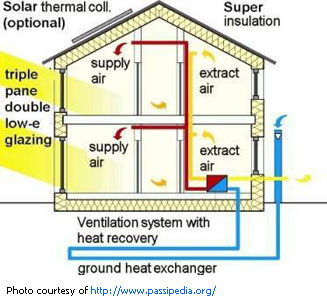Creating Energy-Efficient Housing
"Passive house" (Passivhaus in German) refers to the rigorous, voluntary, Passivhaus design program standard for energy efficiency in a building, which is administered by the Passivhaus Institute in Darmstadt, Germany.
 The program promotes highly-insulated, low-energy buildings that are primarily heated by passive solar gain and by internal heat gains from people and appliances. Energy losses are minimized through the use of superinsulation, high performance triple-glazed windows, a low indoor air change rate (not more than 0.6 times the house volume per hour) and eliminating gaps in the building envelope. Any remaining heat demand is provided by an extremely small heat source. Excessive heat gain is limited through shading and window orientation, and an energy recovery ventilator provides a constant, balanced fresh air supply. The result is a building system that not only saves up to 90 percent of space heating costs, but also provides superior indoor air quality. Learn more.
The program promotes highly-insulated, low-energy buildings that are primarily heated by passive solar gain and by internal heat gains from people and appliances. Energy losses are minimized through the use of superinsulation, high performance triple-glazed windows, a low indoor air change rate (not more than 0.6 times the house volume per hour) and eliminating gaps in the building envelope. Any remaining heat demand is provided by an extremely small heat source. Excessive heat gain is limited through shading and window orientation, and an energy recovery ventilator provides a constant, balanced fresh air supply. The result is a building system that not only saves up to 90 percent of space heating costs, but also provides superior indoor air quality. Learn more.
Passive House designs can cost more than conventional houses, but eliminating the cost of a normal heating system can be used to upgrade other aspects of a building's design such as the building envelope and the heat recovery ventilation system. With careful design and increasing competition in the supply of the specifically designed Passive House building products, in Germany it is now possible to construct buildings for the same cost as those built to normal German building standards. In the US, Passive House designs can cost between 5% - 10% more than conventional construction. Learn more.
In the area of super energy efficiency, the Passive House presents an option for new and retrofit construction in residential, commercial, and institutional projects. Designers and builders can become certified in the use of the Passive House standard, which includes computer modeling applications to help ensure that the building will perform as intended after it is built.
While only a few buildings in the US have been built to Passive House standards, more than 25,000 buildings in Europe - from single and multifamily residences, to schools, factories and office buildings - have been designed and built or remodeled to this standard. Many of these have been extensively monitored by the Passivhaus Institut in Darmstadt, analyzing and verifying their performance. Learn more.

